We finally got the Heritage Walk by Sohail Hashmi Sahab on camera. I had to get up and start from my place at 6.55am (I do not leave my house at this hour unless I had to go to school or travelling! Of course, had to make an exception for this!!).
We had decided to meet at Turkman Gate, one of the gates still standing, restored and in good condition. Meanwhile, as others were still on their way, Sohail Sahab, me and our Sahapedia colleague made a quick dash to Holy Trinity Church. Along the way, he remarked on the fake Dargah of Turkman Shah Bayabani (after whom the Gate is named). According to him, he is buried somewhere inside Shahjahanabad, but here, they are making money in his name.
At the Church, the Christmas preparations had started and cheerful, energetic 90 year old Georgina, like always showed us around, and like always asked me about my details! She also told us that the Church organised a Qawwali programme to mark its anniversary, few days back. (Qawwali for Jesus, why not!) Sohail Sahab remarked on the sacred and profane pulpits (Bible is read out from one and accounts discussed from another) . At Kashmere Gate, Chandni Chowk, Fatehpuri, Turkman Gate churches first prayer service is still done in Urdu. (Shahjahanabadi tradition still carrying on).
By this time our friends from Sahapedia had assembled and three of SPA students had also joined us for the walk. We went inside the Turkman Gate compound gate with our cameras, as guard made a gesture of salute/salam to Sohail Sahab. We fixed our equipment and made a circle around him to listen to him as traffic honked around us. He described a legend according to which, somebody had told Firoz Shah Tughlaq and his town planners to extend the city up to Turkman Gate to include Shah Turkman Bayabani's dargah, and the city would survive till eternity! This part largely was wilderness and consisted of a burial ground. One of the reasons that one neighbourhood still is known as "Mohalla Qabristan"(an oxymoron!) and we can still find many graves in the area.
From Turkman Gate we walked straight towards Teliyon ka Phatak to spot the Lakhauri bricks wall falling apart from an erst while Nawab Muzaffar Khan Haveli, now neighbourhood of Oil pressers caste. On the street, bikes and scooters zoomed past us, wondering loudly 'TV wale hain/ journalist hain" etc. as one goat decided to chew on a colleague's delicious shawl!
Further down the street, we went to recently pre-fixed with "Shahi"- Kalan Masjid, where construction was going on. A mosque from pre- Mughal period by Juna Shah Telengani showing some Tughlaq era style arches, covered by bright Green paint, Marble flooring and granite tiles, etc. now. Mosque was built on a high platform, mostly on the ground floor shops were built, whose rent helped with the maintenanace. Kalan Masjid meaning big, became Kali masjid for the neighbourhood walas, as the mosque lost its grandeur until it got painted in bright green and other colors.
We also spotted some really healthy cats at Bulbuli Khana (literally place for bulbuls, named after a girls' school which was moved from here to Asaf Ali Road), where we stopped for tea.
From there, we walked towards Sitaram Bazar, trying to trace Haksar Haveli on a street where Jawahar Lal Nehru's barat came and he had married Kamla Nehru. Kayasths and Kashmiri Pandits were very good at adapting languages and were part of Mughal courts, lived here. Kids on the street looked at girls', then at Sohail Sahab and then at the building, surprised some smirked and even commented on the interest' in the old, falling apart buildings!
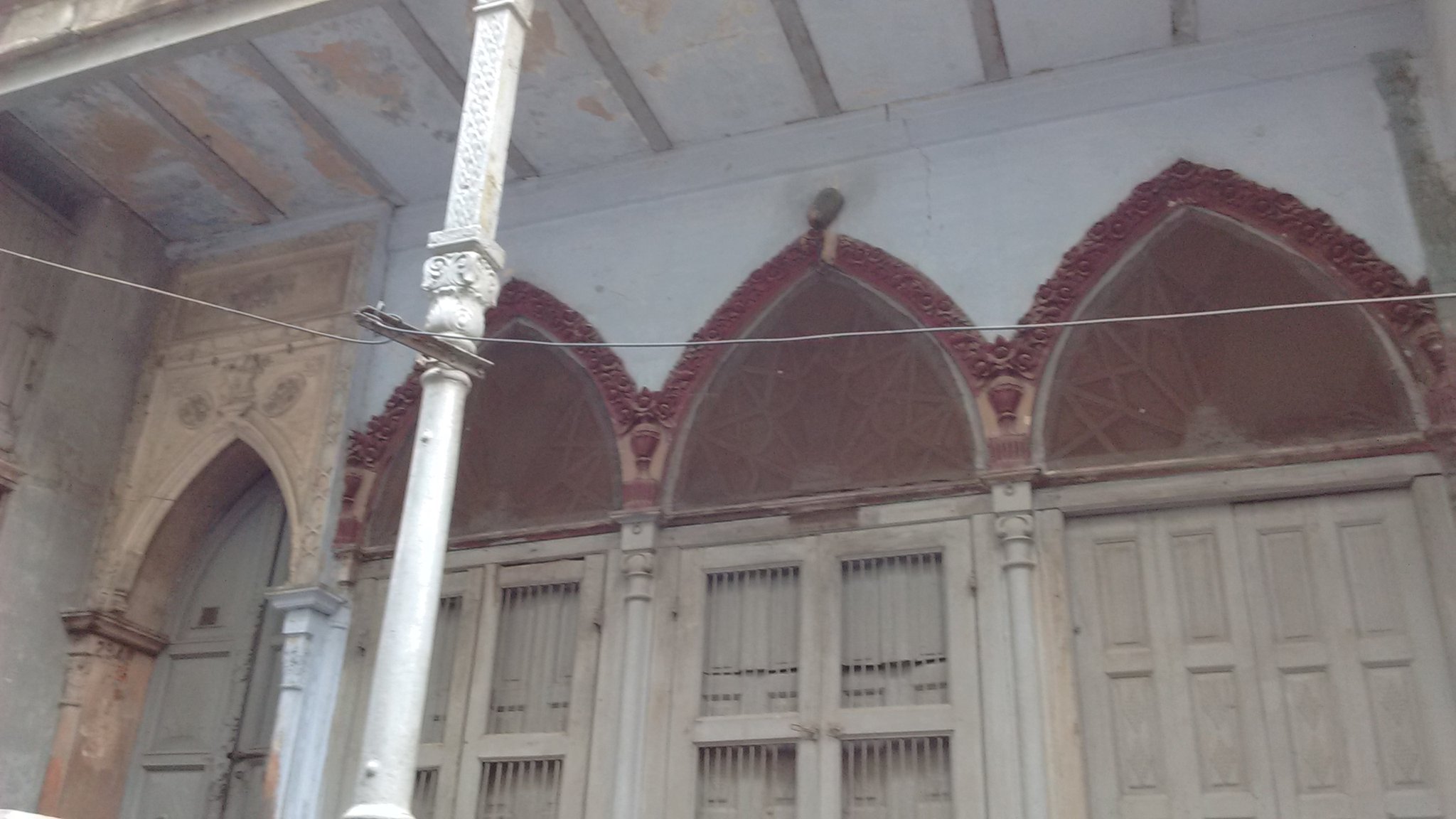 From the Mosques we went to temples (Chaurasi ghanta/ 84 bells), and havelis of Kucha Mai Dass where some of Delhi's wealthiest lived (Shri Rams, for instance). The rich since, have moved out and their havelis are in bad condition. Beautiful Gothic art still prominent on the gates, shows the European influence on architecture.
From the Mosques we went to temples (Chaurasi ghanta/ 84 bells), and havelis of Kucha Mai Dass where some of Delhi's wealthiest lived (Shri Rams, for instance). The rich since, have moved out and their havelis are in bad condition. Beautiful Gothic art still prominent on the gates, shows the European influence on architecture.
From the narrow streets, passing through a 'Chhatta' (terrace on the first floor joining the two ends of property and providing passage for public) we reached towards Gali Magazine, where gunpowder was stored in the post-1857 period. Some of us were actually shocked to see fat sheeps whose fat had gathered at their bums! There used to be a famous "Akhara" here too.
We came out at Chooriwalan and turned towards Masjid Nawab Rukun ud Dawla, one of the most beautifully carved mosques. Small mosque (for Hanafis) with flattened Roman style arch over Mughal cusped arch, showing the acceptance of British domination. The old Mosque caretaker does the most amazing cleanest mending of clothes- darning, etc. It was just our group and the place was empty so we tried to make sense of everything that we found written on the wall/ even tried to guess the text behind the wall clock. Everyone clicked selfies/ photographs of the beautiful carvings and jaalis. Opposite the mosque, a little ahead was Dhoomimals' Haveli (Art Gallery fame'), now being used as a primary school on first floor and a godown on the ground floor.
 We entered a narrow passage opposite Gujarat Namkeens at Chawari Bazar to emerge at Jain Sandwiches, famous for his fruit sandwiches. Two brothers running the shop for over 40-50 years, started by their father. A small little clean place with few chairs and tables to sit. We rested ourselves and waited for our fruit- mix sandwiches with filling of chutney, apples, pomegranates, cucumber, butter,cheese/ paneer bits served with green mint chutney. They also serve coffee, tea etc.
We entered a narrow passage opposite Gujarat Namkeens at Chawari Bazar to emerge at Jain Sandwiches, famous for his fruit sandwiches. Two brothers running the shop for over 40-50 years, started by their father. A small little clean place with few chairs and tables to sit. We rested ourselves and waited for our fruit- mix sandwiches with filling of chutney, apples, pomegranates, cucumber, butter,cheese/ paneer bits served with green mint chutney. They also serve coffee, tea etc.
Once we came out of the shop we had wedding cards' shops all around us. Buildings here displayed the traces of Art- Deco movement, with Swastika, rising sun and other angular, symmetrical geometric forms. One building at Aligarh similarly, was modeled on the old Murphy radio design, said Sohail Sahab.
We walked straight to Shyam Sweets for our Proper breakfast finally! Bedami poori/aloo and chhole sabzi, rounded off with halwa and nagauri.
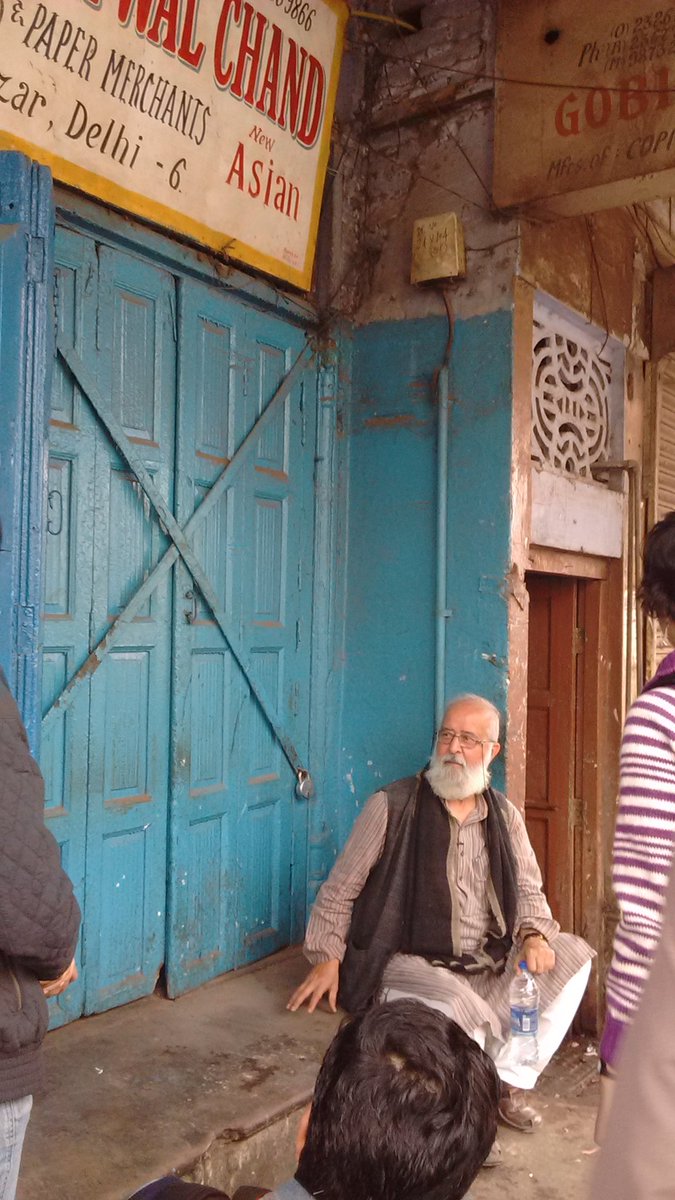 Post heavy breakfast, everybody was walking slow. Sohail Sahab decided to sit at one of the shops and explained how the use of shutters led to the decline of street addas and street sellers. Earlier the color and design of doors were markers of shops and extra space outside was used by people to sit/ gossip/ drink tea/ play cards/ for ear cleaners/ faqirs, etc.
Post heavy breakfast, everybody was walking slow. Sohail Sahab decided to sit at one of the shops and explained how the use of shutters led to the decline of street addas and street sellers. Earlier the color and design of doors were markers of shops and extra space outside was used by people to sit/ gossip/ drink tea/ play cards/ for ear cleaners/ faqirs, etc.
As we came out of the Chawri street, to go towards Jama Masjid, we noticed many hotels on the road opposite Jama Masjid and the pavements full of beddings and Razai sellers. Here, Sohail Sahab gave a long description with examples of how bazars formed a harmonious pattern of related trades.
We walked from there and reached the steps of Jama Masjid and sat there. Sohail Sahab explained how the Jama Masjid design has been copied and has influenced many subsequent mosques which came up later in the sub-continent (Badshahi Mosque of Lahore, Zeenat ul Masjid, etc). He also talked about the Meena Bazar market, Dargahs of Sufi Sarmad and Hare Bhare Shah with their stories and legends. He left from Jama Masjid and promised to finish the Jain temples and Dariba part post- permissions etc. later in the coming week.
Most of our Sahapedia friends had left and students' left too, it was just the four of us now! We rested for sometime, went to Dariba to buy water, as my friend did not want to pay Imam's eatery, also offering X-Rays, and other medical tests with samosas/ tea/ sandwiches! (A rare eating outlet, run by Imam and his family, doubling up as a Medical center!)
Finally, we went inside Jama Masjid post- afternoon prayers. At the gate, I had to make a call to my contact, an important person at office (as I discovered later) to allow us to take our cameras inside and to shoot in the premises.
We left our shoes near the ticket counter for Minar, as it was less crowded and asked the ticket guy for four tickets. He decided to act difficult and refused the cameras! I again had to call up the Very-Important-Office guy. He came out of his office and told the ticket counter guy, "Madam is from Jamia, let them go"!
He waived off even the ticket fee for us. From this moment on wards, we got the "Son-in-law/ damad wala treatment"(as per my friend!) as we saw how rudely the staff behaved with others. On the first floor we rested, took a few profile shots/ selfies, before we entered the narrow long dark passage .
The crowds with young kids, women, men kept climbing. Nobody was regulating the numbers, only one person could stand at one time, and if somebody came from opposite direction both had to give each other space by breathing in the tummy, crawling up the cold wall to pass. Huffing and puffing we reached the top to see it full of people. One generous family with their two kids decided they had enough of the view and proceeded towards the stairs, so we got ourselves some space to stand and to take out our cameras. The view and the shots from the top were beautiful. Just that it required one of our friends to stand with both hands stretched in Shahrukh Khan pose, to stop us from falling! It was a solo human chain trying to stop any possible misstep!
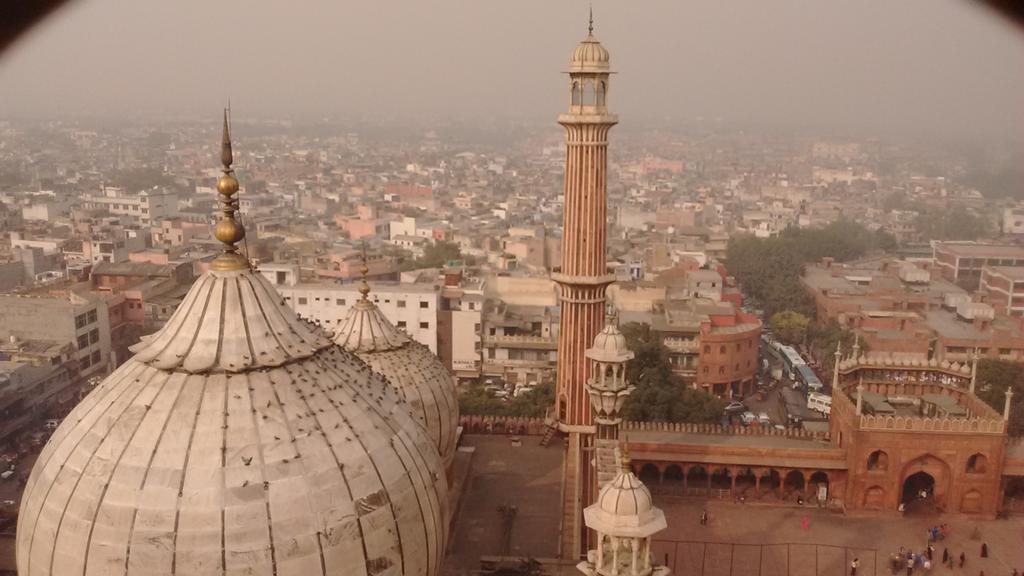 We clicked some photos, selfies were too dangerous to be attempted! We discussed and debated with others, how the authorities could improve it and make it safe for people. At last, as the crowds kept coming up,we decided to climb down. That was another task in itself! Jostling for space, going past fat Aunty, holding her hurting knees, young girls, two of us just made our way out somehow! The other two who were more polite came after fifteen minutes!
We clicked some photos, selfies were too dangerous to be attempted! We discussed and debated with others, how the authorities could improve it and make it safe for people. At last, as the crowds kept coming up,we decided to climb down. That was another task in itself! Jostling for space, going past fat Aunty, holding her hurting knees, young girls, two of us just made our way out somehow! The other two who were more polite came after fifteen minutes!
In the warm sun, the Maulana responsible for keeping track of numbers was reading the newspaper, as his helper asked people to show their Minar tickets. I asked him which paper he was reading, he showed two papers- one Avadhnama (Delhi edition) and Roznama Khabrein. Very kind souls, until we saw them shouting at people!
We decided to take some more photos, before we came back to the main compound. Here unanimously we decided breaking for lunch at Karim's. Few more snaps and we reached Karim's ordered lots of food, and surprisingly finished it all!!
Video links-
Video 1 on Jama Masjid-
https://www.youtube.com/watch?v=Pgrn3ty3u8o&t=68s
Video links-
Video 1 on Jama Masjid-
https://www.youtube.com/watch?v=Pgrn3ty3u8o&t=68s
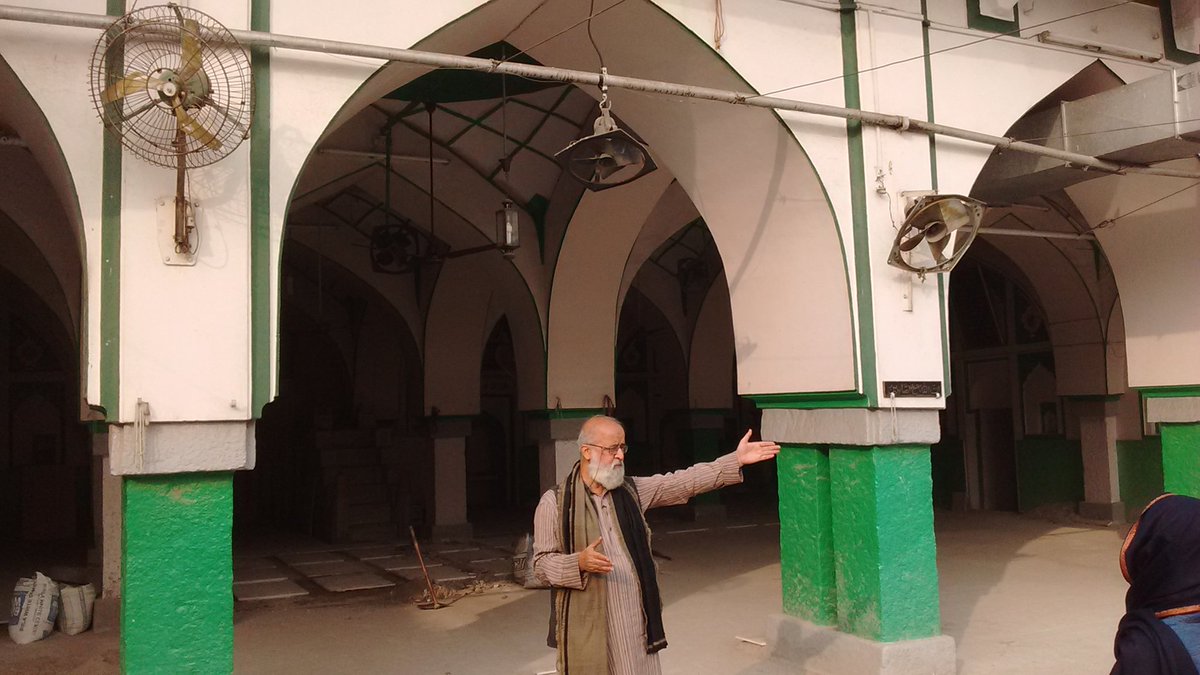
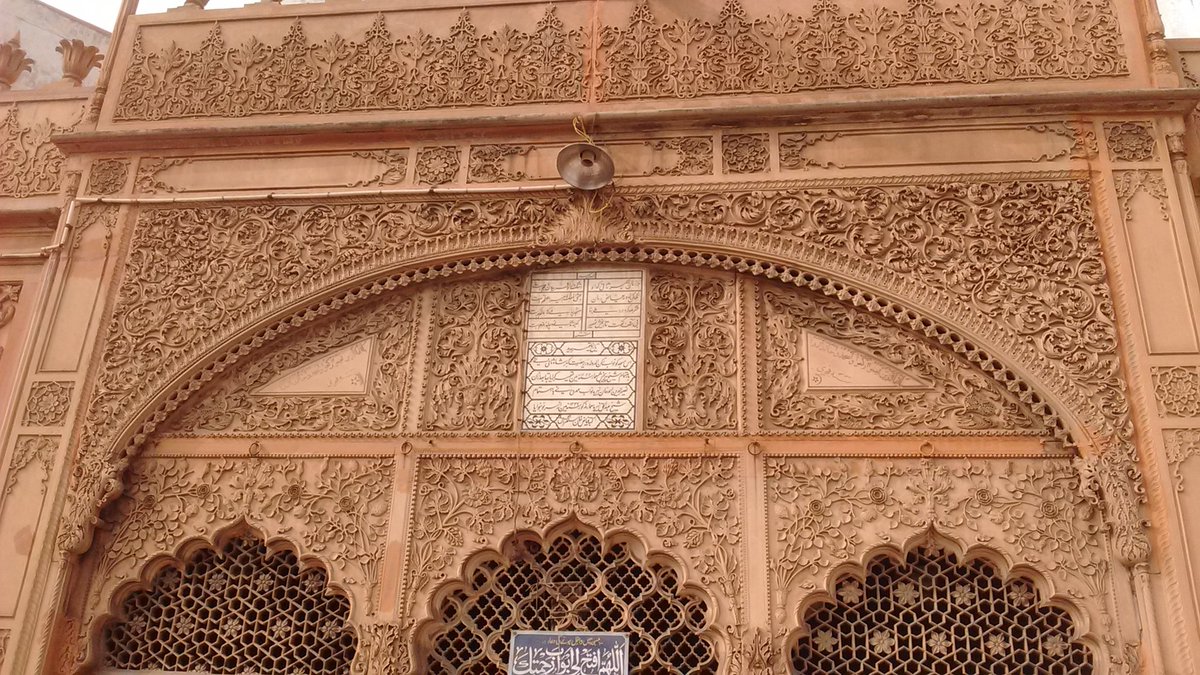

No comments:
Post a Comment